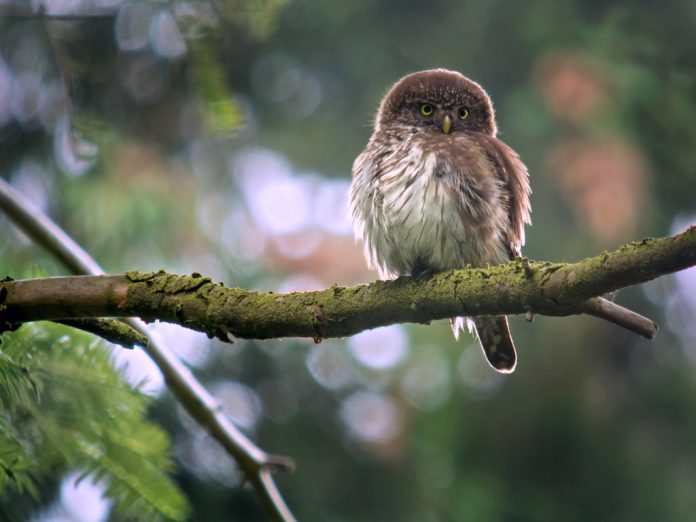The size of the Eurasian Pygmy Owl is approximately 17–18 cm in length, with a wingspan of 35–36 cm. Eurasian Pygmy Owl is a tiny owl, no larger than a Common Starling, which it fleetingly resembles when passing overhead. In good view, longer (thus more obvious) tail, dark barring on breast and flanks, short white brows, a white-spotted facial disc, and lack of large, obvious white spotting on scapulars distinguish adult from superficially similar adult Tengmalm’s and dark races of Little, even if tiny size not obvious.
Tengmalm’s also has a much larger head and a much paler and much more distinct (black-bordered) facial disc with a very different expression, looking wide-eyed with astonishment rather than fierce and annoyed (Eurasian Pygmy gives the impression of a frowning elf). All these features, except barring on breast and flanks, and white-spotted facial disc, can also be used to separate juveniles.
Eurasian Pygmy Owl flight is markedly undulating, woodpecker-like, over long distances; swift, dashing and nimble when in pursuit of prey. The owl tends to perch rather upright, but sometimes more horizontal, often waving its tail from side to side, or flicking it up and down. Sometimes sits with a tail half-cocked. The owl hunts mostly at dusk and dawn, but also during the day (not at night).
Eurasian Pygmy Owl seldom detected in daylight by its rhythmic call, frequently delivered from the top of tall spruce. The juvenile owl resembles an adult, but the head, upperparts, and wing coverts darker and with only indistinct pale spotting, facial disc darker, upper breast uniformly dark rather than barred, lower breast and flanks without dark barring, and dark streaks on underparts less distinct.
The immature Eurasian Pygmy Owl closely resembles an adult, but lacks white eye-like marks on the nape and has paler (rufous-brown), poorly defined barring extending right across the breast (compared with well-defined, blackish barring barely meeting in the center of the breast in adult); often warmer-toned above, with only small buff specks on the crown (instead of larger white spots that often run together to form short bars).
The advertising call of the male Eurasian Pygmy Owl (delivered at dawn and dusk, sometimes in the daytime but rarely at night) is a repeated, soft but far-carrying, fluting whistle: ‘hyew’ (once every 1 to 2 seconds). Quite like the call of European Scops, but shorter and repeated more frequently. It has also recalled Common Bullfinch. At close range, sounds more like ‘hyewk’. When energized intersperse little shorter, lower-pitched, vibrating hoots between usual calls: ‘hyew…huhuhu…hyew…huhuhu…hyew’.
The female Eurasian Pygmy Owl sometimes gives a similar but more nasal ‘hyeelk’. Both sexes give a series of shrill, fluty notes, especially when establishing territory in autumn: ‘cheek-cheek-cheek-cheek-cheek-cheek …’. Sounds like a bicycle pump with a finger over the hole, rising in pitch and speed of delivery. Female and young beg with thin, Robin-like ‘tseeeeeh’, falling in pitch at the end.
It is not uncommon (but elusive in late spring and summer in spite of crepuscular and diurnal hunting). The habitats are coniferous and mixed forest (only in uplands in the south), and often visiting clearings, bogland edges, etc. while hunting every now and then frequents broadleaved woodland, farms, or even gardens in winter.
Read More – Long-Eared Owl Sound











